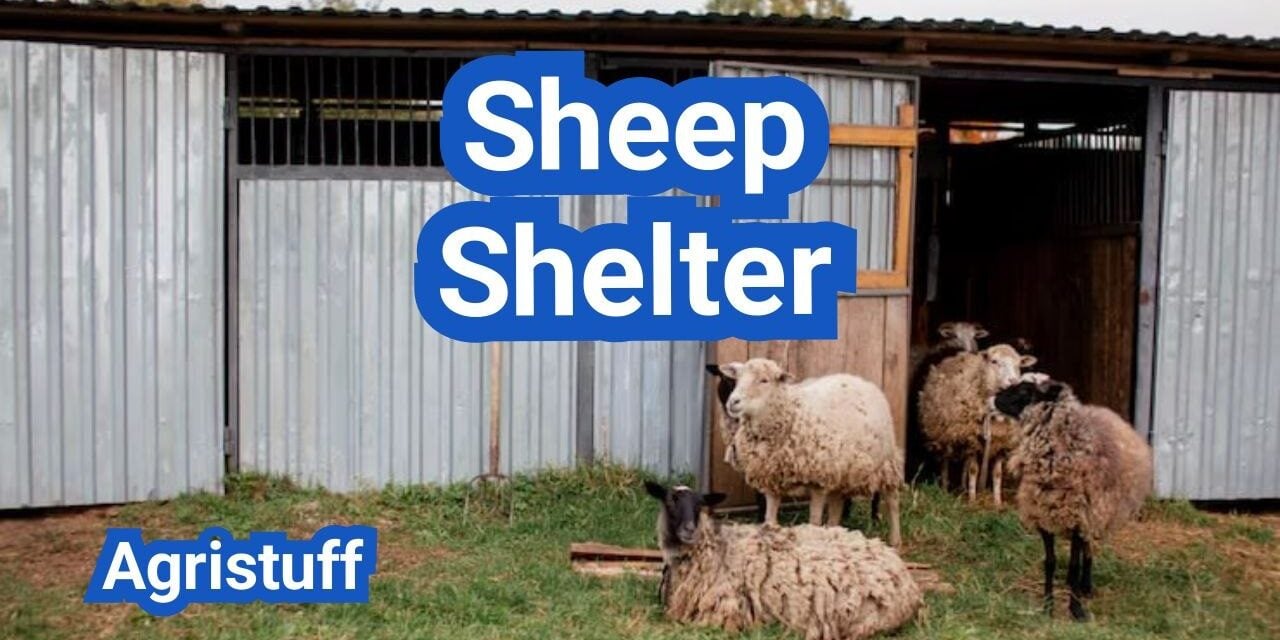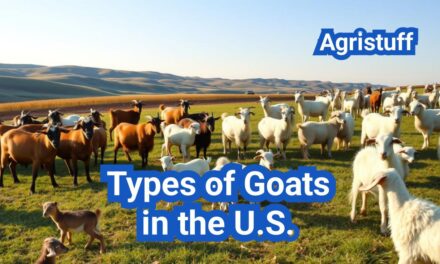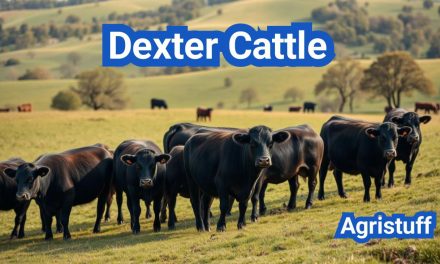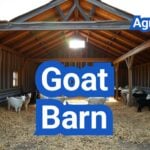Providing adequate housing for livestock is crucial for their health and well-being. The design and construction of animal enclosures vary significantly based on climate, lambing seasons, and the shepherd’s management preferences.
In regions with harsh weather conditions, draft control and proper ventilation are vital to maintaining a healthy environment. Adequate bedding is also essential for keeping animals dry and comfortable.
Moreover, predator safety is a critical consideration when designing livestock housing. A well-designed enclosure can protect animals from potential threats, ensuring their safety and security.
Key Takeaways
- Proper housing design is crucial for livestock health.
- Climate and management practices affect housing needs.
- Draft control, bedding, and predator safety are essential components.
- Adequate ventilation is vital for a healthy environment.
- Predator proofing is critical for animal safety.
Understanding Sheep Shelter Needs
Sheep need protection from extreme weather conditions, making shelter a critical aspect of their care. Adequate shelter helps protect sheep from harsh weather, predators, and other environmental stressors.
Why Sheep Need Protection
Sheep are vulnerable to various environmental factors, including extreme temperatures, precipitation, and wind. Proper shelter provides them with the necessary protection to maintain their health and well-being. Without adequate shelter, sheep can suffer from heat stress, hypothermia, and other weather-related illnesses.
In addition to protecting sheep from harsh weather, shelter also plays a crucial role in safeguarding them against predators. Secure shelter can help reduce the risk of predation, ensuring the safety of the flock.
Climate Considerations in the U.S.
The United States encompasses a wide range of climates, from the hot and humid conditions in the south to the cold and snowy conditions in the north. When designing a sheep shelter, it is essential to consider the local climate and its potential impacts on the flock.
In regions with extreme temperatures, shelter design should prioritize insulation and ventilation to maintain a comfortable environment for the sheep. In areas prone to high winds or heavy precipitation, shelter should be designed to withstand these conditions, providing a safe and dry space for the flock.
By understanding the specific climate considerations in your region, you can design a sheep shelter that meets the unique needs of your flock, ensuring their health and well-being.
Planning Your Sheep Shelter

Effective sheep shelter planning involves understanding your flock’s size and requirements. A well-planned shelter is crucial for the health and well-being of your sheep.
Assessing Your Flock Size and Requirements
The size and type of shelter needed depend largely on the number of sheep you have and your management practices. To determine the appropriate shelter size, consider the following factors:
- Flock size: The number of sheep you need to shelter.
- Age and health status: Lambs, pregnant ewes, and sick sheep may require special considerations.
- Management practices: Whether you keep your sheep indoors or outdoors, and how often you move them.
For instance, a larger flock may require a more extensive shelter or multiple smaller shelters. It’s also essential to consider the specific needs of different age groups within your flock.
Site Selection and Orientation
Choosing the right site for your sheep shelter is critical. Consider the following:
- Natural protection: Look for areas that provide natural protection from wind, rain, and sun.
- Drainage: Ensure the site is well-drained to prevent waterlogging.
- Accessibility: The shelter should be easily accessible for feeding, watering, and monitoring your sheep.
Proper orientation can also help regulate the internal temperature of the shelter. For example, in colder climates, orienting the shelter to face south can help capture warmth from the sun.
Budget Considerations
Budget is a significant factor in sheep shelter planning. Here are some budget-friendly tips:
- Consider using locally sourced materials for construction.
- Repurpose existing structures where possible.
- Plan for future expansion to avoid costly renovations.
By carefully assessing your flock size, selecting an appropriate site, and considering your budget, you can plan a sheep shelter that meets your needs without breaking the bank.
Types of Sheep Shelters
Various types of shelters are available for sheep farming, each with its unique benefits. The choice of shelter depends on factors such as climate, flock size, and management practices.
Three-Sided Shelters
Three-sided shelters are a popular choice among sheep farmers due to their simplicity and effectiveness. These shelters provide protection from wind and rain while allowing for good ventilation.
Advantages: Easy to construct, cost-effective, and provides good protection from the elements.
Fully Enclosed Barns
Fully enclosed barns offer comprehensive protection from the elements and predators. They are ideal for harsh climates or when additional security is needed.
Benefits: Complete protection from weather and predators, can be used in extreme climates.
Mobile Shelter Options
Mobile sheep shelters provide flexibility, allowing farmers to move the shelters to different grazing areas. This helps in maintaining pasture health and reducing parasite buildup.
Key Features: Portability, ease of movement, and ability to rotate grazing areas.
Repurposed Structures
Repurposing existing structures, such as old barns or containers, can be a cost-effective way to provide shelter for sheep. This approach also adds a sustainable element to farming practices.
Advantages: Cost-effective, environmentally friendly, and can add character to the farm.
| Shelter Type | Protection Level | Cost | Flexibility |
|---|---|---|---|
| Three-Sided Shelters | Moderate | Low | Moderate |
| Fully Enclosed Barns | High | High | Low |
| Mobile Shelter Options | Moderate | Moderate | High |
| Repurposed Structures | Varies | Low | Moderate |
Essential Space Requirements for Sheep

Providing sufficient space for your sheep is essential for maintaining a healthy flock. Adequate space allows sheep to move comfortably, reducing stress and the risk of disease transmission.
Per-Animal Space Allocation
The amount of space required per sheep varies depending on factors such as age, size, and management practices. Generally, a minimum of 15-20 square feet per sheep is recommended for indoor shelter. However, this can vary based on breed and size. For example, larger breeds may require more space.
When calculating per-animal space allocation, consider the following factors:
- Age: Lambs and ewes with lambs may require more space.
- Size: Larger sheep breeds need more room.
- Management practices: Intensive management may require more space for feeding and watering areas.
Feeding and Watering Areas
Adequate space for feeding and watering is crucial to prevent competition and stress among sheep. A general rule of thumb is to provide at least 1-2 feet of feeding space per sheep and ensure that water is easily accessible. The design of feeding and watering areas should facilitate easy cleaning and minimize waste.
Pasture Shelter Dimensions
When designing pasture shelters, consider the size of your flock and the climate. A three-sided shelter should be large enough to accommodate all sheep comfortably. A general guideline is to provide a minimum of 8-10 square feet per sheep under the shelter. The shelter should be oriented to protect from prevailing winds and precipitation.
By carefully planning the space requirements for your sheep, you can create a more comfortable and healthy environment, ultimately improving the productivity of your flock.
Designing a Functional Sheep Shelter
Designing a sheep shelter requires careful consideration of several key factors to ensure the well-being of your flock. A functional sheep shelter provides adequate ventilation, protection from the elements, and easy access for management practices.
Roof Height and Pitch
The roof height and pitch are critical components of sheep shelter design. A higher roof allows for better ventilation and can accommodate taller sheep or equipment. The pitch of the roof should be steep enough to shed snow and rain efficiently.
A minimum roof height of 8 feet is recommended to allow for adequate ventilation and ease of movement. The pitch should be between 4:12 and 6:12 to ensure effective water runoff.
Wall Construction
Wall construction is another vital aspect of sheep shelter design. The walls should be sturdy enough to withstand wind and weather conditions. Materials such as wood, metal, or a combination of both can be used.
Consider using durable materials that can resist rot, rust, and damage from sheep. The walls should be at least 4 feet high to provide adequate protection.
Flooring Options
The choice of flooring is crucial for maintaining cleanliness and dryness within the shelter. Options include concrete, dirt, or gravel floors.
- Concrete floors are durable and easy to clean but can be hard on the sheep’s joints.
- Dirt floors are more comfortable for sheep but may require more frequent cleaning.
- Gravel floors offer a compromise between durability and comfort.
Layout Considerations
The layout of the sheep shelter should facilitate easy movement and management. Consider the placement of feeding and watering areas, as well as any lambing or sick pens.
A well-planned layout can improve the overall efficiency of your sheep operation. Ensure that there is adequate space for all sheep to stand comfortably and move around.
Effective Draft Control Strategies

A well-designed sheep shelter with effective draft control can significantly improve the overall health of the flock. Draft control is essential to maintaining a healthy and comfortable environment for sheep.
Understanding Air Movement
Air movement within a sheep shelter plays a critical role in maintaining a healthy environment. Proper ventilation helps remove moisture and ammonia from the shelter, reducing the risk of respiratory issues in sheep. Understanding how air moves through the shelter is crucial for effective draft control.
Windbreak Designs
Windbreaks are a crucial element in controlling drafts within sheep shelters. Strategically placed windbreaks can protect the shelter from harsh winds, reducing the chill factor and preventing cold air from penetrating the shelter. Various materials can be used for windbreaks, including wood, metal, and fabric.
Seasonal Adjustments
Sheep shelters require seasonal adjustments to ensure optimal draft control throughout the year. During winter, additional measures may be needed to prevent cold drafts, while in summer, ventilation may need to be increased to prevent overheating.
Draft Prevention Materials
The choice of materials for draft prevention is critical. Insulating materials such as straw, hay, or specialized insulation products can be used to line the shelter and prevent drafts. Additionally, materials like plastic or metal can be used to create barriers against wind and rain.
By implementing these effective draft control strategies, sheep farmers can create a more comfortable and healthy environment for their flock, ultimately improving the overall productivity and well-being of the sheep.
Sheep Barn Ventilation Systems

Effective sheep barn ventilation systems are key to preventing health issues in sheep. Adequate ventilation is crucial for maintaining a healthy environment for sheep, removing moisture and ammonia from the barn, and reducing the risk of respiratory problems.
Natural Ventilation Methods
Natural ventilation relies on the natural flow of air through the barn, using openings such as windows, doors, and vents to facilitate airflow. This method is energy-efficient and can be highly effective in mild climates.
- Orientation of the barn to take advantage of prevailing winds
- Use of ridge vents or roof monitors to allow warm air to escape
- Installation of sidewall vents or windows that can be opened and closed as needed
Benefits of Natural Ventilation: It reduces the need for mechanical systems, potentially lowering energy costs and minimizing the barn’s carbon footprint.
Mechanical Ventilation Options
In cases where natural ventilation is insufficient, mechanical ventilation systems can be employed to ensure adequate airflow. These systems use fans to circulate air, improving ventilation and helping to maintain a consistent temperature.
- Exhaust fans to remove stale air
- Supply fans to bring in fresh air
- Combination systems that integrate both exhaust and supply fans
Mechanical ventilation is particularly useful in larger barns or in climates with extreme temperatures.
Balancing Airflow and Temperature
Balancing airflow and temperature is critical for maintaining a comfortable environment for sheep. Too much airflow can lead to drafts, while too little can result in stagnant air.
“The key to effective ventilation is finding the right balance between airflow and temperature control, ensuring that the barn remains comfortable for the sheep without wasting energy.” – Agricultural Expert
To achieve this balance, farmers can adjust ventilation systems seasonally, using natural ventilation during mild weather and supplementing with mechanical ventilation during extreme temperatures.
By implementing effective ventilation strategies, sheep farmers can significantly improve the health and well-being of their flock, ultimately enhancing the overall productivity of their operation.
Optimal Bedding for Sheep Comfort

The comfort and health of sheep are significantly influenced by their bedding. Proper bedding can prevent health issues, reduce stress, and improve overall flock well-being.
Bedding Material Comparison
Various bedding materials are available, each with its pros and cons. Common options include straw, hay, sand, and wood shavings.
- Straw: Absorbent and comfortable, but can be expensive.
- Hay: Can be used, but may cause digestive issues if ingested.
- Sand: Good drainage, but can be abrasive.
- Wood Shavings: Absorbent and comfortable, but may contain harmful chemicals if not properly sourced.
According to agricultural experts, “The choice of bedding material should be based on availability, cost, and the specific needs of the flock.”
Deep Litter System Implementation
A deep litter system involves allowing bedding material to accumulate over time, creating a composting layer that can help reduce waste and odor.
Benefits include reduced labor for cleaning and improved flock health due to the dry and warm environment.
“A well-managed deep litter system can significantly reduce the need for frequent cleaning and provide a comfortable environment for sheep.”
Cleaning and Replacement Schedules
Regular cleaning and replacement of bedding are crucial to maintaining a healthy environment.
The frequency of cleaning depends on factors such as flock size, shelter design, and bedding material.
| Bedding Material | Cleaning Frequency | Replacement Frequency |
|---|---|---|
| Straw | Weekly | Monthly |
| Sand | Bi-Weekly | Quarterly |
| Wood Shavings | Weekly | Monthly |
By understanding the different bedding options and implementing an appropriate cleaning schedule, farmers can significantly improve the comfort and health of their sheep.
Specialized Lambing Areas
Specialized lambing areas play a vital role in reducing stress and promoting the health of ewes and lambs during the lambing season. These areas are designed to provide a safe and clean environment, crucial for the well-being of both the ewes and their newborn lambs.
Lambing Jug Size and Design
Lambing jugs are individual pens used to house ewes and their lambs immediately after birth. The size and design of these jugs are critical for ensuring the ewes can bond with their lambs and for reducing the risk of lambs being laid on or crushed.
A typical lambing jug size is around 4 feet by 4 feet, providing enough space for the ewe and her lambs to move comfortably. The design should include features such as:
- Easy-to-clean surfaces
- Adequate ventilation
- Protection from drafts
- Enough space for the ewe to stand up and lie down comfortably
| Lambing Jug Feature | Importance | Design Consideration |
|---|---|---|
| Size | High | 4×4 feet or larger |
| Ventilation | High | Adequate airflow without drafts |
| Cleaning Access | Medium | Easy-to-clean surfaces |
Temporary Lambing Shelter Options
In some cases, farmers may need temporary lambing shelter options due to seasonal changes or flock size adjustments. These can include:
- Portable lambing pens
- Tent-like structures
- Repurposed shipping containers
These temporary shelters should still provide the necessary protection and comfort for ewes and lambs.
Equipment and Supplies
Having the right equipment and supplies is crucial for managing a lambing area effectively. Essential items include:
- Heat lamps or other warming devices
- Lambing kits with necessary supplies like gloves and obstetric equipment
- Feed and water buckets
- Bedding materials like straw or sand
Ensuring that these supplies are readily available can help in managing the lambing process more efficiently and reducing stress on both the ewes and the farm staff.
Winter Sheep Shelter Considerations

Winter brings unique challenges for sheep shelters, requiring careful planning to ensure the health and safety of the flock. Adequate shelter during this period is crucial for protecting sheep from extreme cold and snow, which can lead to stress, illness, and even death if not managed properly.
Insulation Techniques
Proper insulation is key to maintaining a warm and dry environment within the sheep shelter. Techniques include using materials like straw, hay, or specialized insulation panels to line the walls and roof of the shelter. Deep bedding with straw or hay not only provides comfort but also acts as a natural insulator, helping to keep the cold out and the warmth in.
Heat Management Without Electricity
Managing heat without relying on electricity is both cost-effective and environmentally friendly. Using passive heating methods, such as maximizing southern exposure for sunlight, can significantly warm the shelter. Additionally, ensuring that the shelter is draft-free helps retain whatever heat is generated within.
Snow Load Planning
Snow load planning is critical to prevent the collapse of the sheep shelter under the weight of snow. This involves designing the roof with a sufficient pitch and strength to handle snow loads. Regularly clearing snow from the roof is also essential, especially after heavy snowfalls.
Keeping Water Sources Unfrozen
Ensuring that water sources remain unfrozen is vital for the health of the sheep. Using heated water buckets or insulated water systems can prevent freezing. Regularly checking water sources to ensure they are accessible and unfrozen is crucial, as sheep need constant access to water.
Summer Shade and Cooling Solutions

Sheep are particularly vulnerable to heat stress during the summer months, making it essential to implement effective shade and cooling strategies. Heat stress can lead to a range of health issues, from decreased productivity to life-threatening conditions.
Heat Stress Prevention
Preventing heat stress in sheep involves a combination of providing adequate shade, ensuring good ventilation, and managing their environment to reduce heat load. One effective method is to adjust the sheep’s activity patterns to avoid the hottest parts of the day.
Key strategies for heat stress prevention include:
- Providing shade structures or trees to block direct sunlight
- Ensuring access to plenty of cool, clean water
- Adjusting feeding times to cooler parts of the day
- Monitoring weather forecasts to prepare for heatwaves
Portable Shade Structures
Portable shade structures offer a flexible solution for providing shade to sheep, especially in rotational grazing systems. These can be moved to follow the sheep as they graze different areas.
| Type of Shade Structure | Benefits | Considerations |
|---|---|---|
| Canvas Canopies | Lightweight, easy to move | May not be durable in harsh weather |
| Metal Frame Shades | Sturdy, long-lasting | Can be heavy, more expensive |
| Tree Shade | Natural, no additional cost | Limited by tree location and density |
Water Access Planning
Ensuring that sheep have access to clean, cool water is critical for their health, especially during hot weather. Watering systems should be designed to prevent contamination and ensure that water remains cool.
“Adequate water supply is crucial for sheep health, particularly in hot climates where dehydration can occur rapidly.”
Effective water access planning involves:
- Regularly checking water quality and quantity
- Using shaded watering systems or cooling the water
- Positioning water sources in shaded areas
By implementing these summer shade and cooling solutions, sheep farmers can significantly reduce the risk of heat stress and improve the overall welfare of their flock.
Building a DIY Sheep Shelter

For sheep farmers, constructing a DIY sheep shelter is a cost-effective way to ensure the well-being of their animals. A well-built shelter protects sheep from harsh weather conditions and predators, improving their overall health and productivity.
Materials List and Budget
Before starting your project, it’s essential to gather the necessary materials and establish a budget. The materials needed may include:
- Lumber for the frame
- Roofing materials (metal, asphalt shingles, or corrugated plastic)
- Wall panels or siding
- Bedding material (straw, hay, or sand)
- Nails, screws, and other fasteners
The budget for your DIY sheep shelter will depend on the size of the structure, the materials chosen, and the labor involved. Consider repurposing materials or using locally sourced products to reduce costs.
Step-by-Step Construction Guide
Building your DIY sheep shelter involves several key steps:
- Plan your shelter: Determine the size based on the number of sheep and the space required for feeding and watering areas.
- Prepare the site: Clear the area, level the ground, and lay a foundation if necessary.
- Construct the frame: Use lumber to create the frame, ensuring it is sturdy and well-supported.
- Install roofing and siding: Choose materials that are durable and weather-resistant.
- Add bedding: Select a comfortable and dry bedding material.
Tools Required
To complete your DIY sheep shelter, you’ll need a variety of tools, including:
- Hammer or nail gun
- Saw (circular or handheld)
- Drill and bits
- Tape measure and square
- Level
Having the right tools on hand will make the construction process smoother and more efficient.
Mobile Sheep Shelter Construction

Constructing a mobile sheep shelter requires careful planning and consideration of several key factors. The primary advantage of a mobile shelter is its flexibility, allowing farmers to practice rotational grazing effectively. This method not only improves pasture health but also enhances animal welfare by providing fresh grazing areas.
Mobility Design Features
A well-designed mobile sheep shelter should incorporate features that facilitate easy movement and setup. Key design elements include:
- Portability: The shelter should be lightweight yet sturdy enough to withstand various weather conditions.
- Ease of Assembly: Simple and quick assembly is crucial for a mobile shelter, allowing farmers to move and set up the shelter efficiently.
- Durability: Materials used should be durable to ensure the shelter remains in good condition despite frequent relocation.
According to agricultural experts, “A mobile sheep shelter should be designed with the flock’s size and the terrain in mind to ensure optimal grazing management.”
This approach not only benefits the sheep but also contributes to sustainable farming practices.
Lightweight Material Selection
Choosing the right materials is critical for the construction of a mobile sheep shelter. The materials should be lightweight to facilitate easy movement, yet robust enough to provide adequate protection for the sheep.
| Material | Weight | Durability |
|---|---|---|
| Aluminum Frame | Low | High |
| Canvas Covering | Low | Medium |
| Wooden Slats | Medium | High |
As shown in the table, materials like aluminum frames and canvas coverings are popular choices due to their lightweight nature and adequate durability.
Moving and Positioning Methods
Effective methods for moving and positioning a mobile sheep shelter are crucial for its successful operation. Farmers can use various techniques, including:
- Towing: Attaching the shelter to a vehicle or tractor for easy relocation.
- Lifting: Using machinery to lift and move the shelter to different locations.
- Manual Relocation: For smaller shelters, manual relocation by a team can be a viable option.
By considering these factors and methods, farmers can construct and utilize mobile sheep shelters effectively, enhancing their grazing management practices.
Predator-Proofing Your Sheep Shelter
Effective predator-proofing of sheep shelters involves understanding the types of predators in your region and using appropriate deterrents. Predator protection is crucial for sheep farms, and various methods can be employed to protect sheep from predators.
Common Predators by Region
The types of predators that threaten sheep vary significantly across different regions in the United States. Understanding these regional threats is crucial for developing effective predator-proofing strategies.
- In the Western United States, coyotes, mountain lions, and bears are common predators.
- In the Southeast, coyotes, bobcats, and wild dogs pose significant threats.
- Foxes and domestic dogs are potential predators in many areas.
Physical Barrier Systems
Creating a robust physical barrier around your sheep shelter is one of the most effective ways to deter predators. This can include:
- Fencing: High-tensile fencing that is at least 6 feet tall can be very effective. Burying the fence 12 inches underground can prevent digging predators.
- Hardware cloth: Using hardware cloth around the shelter and fencing can provide additional protection against chewing predators.
- Secure doors and gates: Ensuring that all access points are secure and difficult to open or breach is crucial.
Guardian Animal Integration
Guardian animals can be an effective and natural way to protect your sheep from predators. Common guardian animals include:
- Dogs: Breeds such as Great Pyrenees, Akbash, and Maremma are known for their guarding abilities.
- Llamas and donkeys: These animals can also serve as effective guardians against predators.
It’s essential to introduce guardian animals to the flock early and ensure they are well-bonded.
Electronic Deterrents
In addition to physical barriers and guardian animals, electronic deterrents can provide an extra layer of protection. These can include:
- Motion-activated lights and sprinklers: These can startle and deter predators.
- Electric fencing: Supplemental electric fencing can enhance the security of your sheep shelter.
- Monitoring systems: Modern technology allows for the use of cameras and sensors to monitor and alert farmers to potential predator threats.
By combining these methods, sheep farmers can significantly enhance the security of their flocks and reduce the risk of predator attacks.
At The End of: Sheep Shelter Essentials
Designing and constructing a sheep shelter requires careful consideration of several key factors, including draft control, bedding, and predator safety. By understanding the specific needs of your flock and incorporating budget-friendly tips, you can create a safe and comfortable sheep shelter.
A well-designed sheep shelter provides protection from the elements and predators, while also ensuring the health and well-being of your sheep. Key considerations include assessing your flock size and requirements, selecting the right type of shelter, and incorporating effective ventilation and bedding systems.
When it comes to sheep housing design, it’s essential to prioritize predator safety. This can be achieved through the use of physical barrier systems, guardian animal integration, and electronic deterrents. By combining these measures, you can create a secure and comfortable environment for your sheep.
By following the guidelines outlined in this article, you can create a sheep shelter that meets the needs of your flock while staying within your budget. Effective sheep shelter design is crucial for maintaining the health and productivity of your sheep, and with the right planning and construction, you can ensure a safe and comfortable home for your animals.
FAQ
What are the essential components of a sheep shelter?
The essential components of a sheep shelter include draft control, bedding, and predator safety. Draft control helps to regulate airflow and prevent cold air from entering the shelter, while bedding provides comfort and warmth for the sheep. Predator safety features, such as fencing and secure doors, help to protect the sheep from predators.
How do different climates in the U.S. impact sheep shelter needs?
Different climates in the U.S. impact sheep shelter needs in various ways. In colder climates, sheep shelters need to provide more insulation and protection from wind and snow, while in hotter climates, they need to provide shade and ventilation to prevent heat stress.
What factors should be considered when planning a sheep shelter?
When planning a sheep shelter, factors such as flock size, site selection, and budget constraints should be considered. The shelter should be designed to meet the specific needs of the flock, taking into account factors such as climate, terrain, and predator risks.
What types of sheep shelters are available, and what are their advantages and disadvantages?
There are several types of sheep shelters available, including three-sided shelters, fully enclosed barns, mobile shelters, and repurposed structures. Each type has its advantages and disadvantages, and the choice will depend on factors such as climate, flock size, and management practices.
How much space is required per sheep in a shelter?
The amount of space required per sheep in a shelter will depend on factors such as the size and breed of the sheep, as well as the type of shelter. A general rule of thumb is to provide at least 10-15 square feet per sheep.
What are the key considerations for designing a functional sheep shelter?
Key considerations for designing a functional sheep shelter include roof height and pitch, wall construction, flooring options, and layout. The shelter should be designed to provide a comfortable and safe environment for the sheep, while also being functional and easy to manage.
How can drafts be controlled in a sheep shelter?
Drafts can be controlled in a sheep shelter by using windbreaks, adjusting the shelter’s orientation, and using draft prevention materials such as curtains or baffles.
What are the best bedding options for sheep?
The best bedding options for sheep include straw, hay, and wood shavings. The choice of bedding will depend on factors such as climate, availability, and cost.
How can lambing areas be designed to meet the needs of ewes and lambs?
Lambing areas should be designed to provide a safe and comfortable environment for ewes and lambs. This can include lambing jugs, temporary lambing shelters, and specialized equipment such as heat lamps and feeding systems.
What are the key considerations for sheep shelters during winter?
Key considerations for sheep shelters during winter include insulation, heat management, snow load planning, and keeping water sources unfrozen.
How can sheep shelters be designed to provide shade and cooling during summer?
Sheep shelters can be designed to provide shade and cooling during summer by using portable shade structures, providing adequate ventilation, and ensuring access to cool water.
What materials are needed to build a DIY sheep shelter?
The materials needed to build a DIY sheep shelter will depend on the design and size of the shelter, but may include fencing, roofing materials, and lumber.
How can a mobile sheep shelter be constructed?
A mobile sheep shelter can be constructed by using lightweight materials, designing the shelter with mobility in mind, and using a trailer or other mobile base.
How can sheep shelters be predator-proofed?
Sheep shelters can be predator-proofed by using physical barrier systems, integrating guardian animals, and using electronic deterrents.
What are the benefits of building a low-cost sheep shelter?
The benefits of building a low-cost sheep shelter include cost savings, flexibility, and the ability to customize the shelter to meet specific needs.
Conclusion of: Sheep Shelter Essentials
Introduction: Why a Sheep Shelter Is a Core Part of Flock Success
A well-designed Sheep Shelter is not just a roof over your flock’s heads—it’s a management tool that protects health, improves growth, and reduces losses in every season. Sheep can tolerate cold better than many people assume, but they struggle when wet, exposed to wind, or stressed by predators. A shelter that keeps animals dry, blocks drafts, and offers a calm resting area helps ewes maintain body condition, supports stronger lambs, and lowers your veterinary costs over time. Penn State Extension sheep housing requirements
What a Sheep Shelter Should Actually Do
The main job of a Sheep Shelter is to reduce environmental stress while letting sheep behave naturally. At minimum, shelter should provide a dry lying area, a windbreak at animal level, and enough space so sheep don’t pile on each other during storms. It also becomes your “working base” for lambing, feeding in extreme weather, and handling sheep safely. Even pasture systems benefit from simple three-sided sheds or portable shelters when weather turns rough. Sheep101 guide to basic sheep housing functions
Picking the Right Shelter Type for Your Farm
Your ideal Sheep Shelter depends on climate, flock size, and whether you confine sheep seasonally or keep them on pasture year-round. In much of the U.S., common options include three-sided run-in sheds, hoop structures, pole barns, or mobile shelters that move with rotational grazing. A smaller backyard flock may only need a simple shed, while a commercial lambing operation benefits from a barn with pens and feed alleys. The best shelter is the one that fits your management style and keeps bedding dry. UMass Extension overview of shelter types and layouts
Site Selection: Dry Ground Beats Fancy Buildings
No matter how good the structure is, a Sheep Shelter placed on a wet site will become a health problem. Choose slightly elevated ground with natural drainage, so rain and snowmelt flow away from the building. If you’re building on soil, a compacted gravel base or crowned pad helps prevent puddling. Poor drainage leads to wet bedding, hoof rot, and higher parasite pressure—so location is your first line of defense. FAO livestock housing site and drainage guidance
Orientation and Wind Protection
A smart Sheep Shelter works with prevailing winds. In most regions, face the open side away from cold winter winds and toward winter sun so sheep stay warmer without drafts. If strong storms are common, add a windbreak wall, panels, or stacked bales during peak winter months. Natural windbreaks like hedgerows help, but they don’t replace a roofed resting area in wet or snowy climates. Extension notes on shelter orientation and windbreaks
Space Requirements Inside the Sheep Shelter
Overcrowding is the fastest way to ruin a Sheep Shelter. Sheep need enough lying room to rest without pushing, and enough standing space to access feed and water calmly. A practical guideline is about 10–14 sq ft per dry ewe, 16–20 sq ft per ewe with lambs, 8–10 sq ft per weaned lamb, and 20–30 sq ft per mature ram. Give more space in humid climates or when sheep are heavily pregnant or unshorn. Oklahoma State Extension space allowance guidance
Draft Control: Stop Wind at Sheep Level
A good Sheep Shelter blocks drafts where sheep lie and stand, while still allowing air exchange above their backs. Drafts happen near the floor through gaps, open corners, or doors facing wind. Seal low cracks, use solid lower walls, and add wind curtains or temporary panels in winter. The goal is calm air at animal height—not a sealed building with stale air trapped inside. Practical draft control for sheep shelters
Ventilation: Fresh Air Without Chilling Sheep
Ventilation is essential in any Sheep Shelter because sheep produce moisture and ammonia even in cold weather. Poor airflow increases respiratory disease, especially in lambs. Ridge vents, open eaves, or adjustable sidewall openings usually work better than trying to “heat” a barn by closing it tight. If your shelter smells like urine or makes eyes sting, it needs more fresh air movement. Ohio State guidance on airflow for small ruminants
Controlling Moisture and Ammonia Buildup
Even with ventilation, a Sheep Shelter must manage internal humidity. Moist air plus manure creates ammonia, which damages lung tissue over time. The simplest rule: if bedding feels damp on top or you smell ammonia at sheep-nose height, increase ventilation and add fresh bedding more often. In still, humid areas, a few well-placed fans can help keep air moving. Government guide on air quality in sheep housing
Best Bedding Choices for Sheep Comfort
Bedding defines how comfortable your Sheep Shelter feels. Straw is the classic option because it insulates well, stays fluffy, and encourages sheep to nest. Wood shavings can work if they’re low-dust and not chemically treated, while chopped stalks or paper-based bedding may be available locally. Whatever you choose must be clean, mold-free, and free of sharp debris. Comfort matters because ewes and lambs spend many hours lying down. University guidance on livestock bedding safety
Deep Litter vs. Frequent Clean-Out Systems
Many producers use a deep-litter system in a Sheep Shelter, adding fresh bedding on top of manure through winter. It’s warm and labor-efficient, but only when you keep a dry surface layer. If deep litter becomes wet and compacted, it turns into a disease factory. The alternative is frequent full clean-outs with a thinner bedding layer. Choose the method that fits your labor schedule and climate. Oregon State notes on litter systems for sheep shelters
Flooring and Drainage Inside the Shelter
The floor of a Sheep Shelter should be firm, non-slippery, and supportive of drainage. Packed clay topped with gravel works well for many small farms; grooved concrete is durable for larger barns but needs thick bedding to prevent leg stress. In wet regions, a slightly sloped floor helps keep urine moving away from resting areas. The best flooring is the one that helps you maintain a dry top bedding layer. Extension guidance on livestock flooring and drainage
Internal Layout: Feeding, Watering, and Traffic Flow
A functional Sheep Shelter makes daily chores easier and reduces stress. Place feeders so most sheep can eat at once without bullying, and keep hay racks along walls to limit waste. Waterers should be easy to clean and protected from bedding contamination. Leave clear alleys for moving sheep, checking udders, or treating sick animals. Simple layout improvements often matter more than extra square footage. Sheep101 guide to feeding and watering setup
Lambing Jugs (Pens) as Part of the Shelter Plan
A Sheep Shelter becomes invaluable during lambing because it lets you create small “jugs” for bonding. Individual pens reduce mismothering, let you monitor milk intake, and protect weak lambs from being trampled. Typical jug size is about 4×4 ft for average ewes and up to 5×5 ft for large breeds. Keep jugs bedded deeply and disinfect between ewes to lower disease risk. Montana Extension lambing pen recommendations
Predator Safety: Make the Shelter a Secure Night Pen
Predator control is part of Sheep Shelter design, not an afterthought. Coyotes and roaming dogs can enter through small gaps, so use solid doors, strong latches, and tight fencing around shelter openings. If sheep sleep outside, a secure electrified perimeter matters, but bringing sheep into the shelter during lambing and high-risk seasons cuts losses sharply. Routine lock-up at dusk trains sheep to return calmly. USDA resources on predator management for sheep
Guardian Animals and Layered Protection
For many farms, the safest approach combines a strong Sheep Shelter with guardian support. Livestock guardian dogs (like Great Pyrenees, Anatolian Shepherds, or Maremmas), as well as guard donkeys or llamas, can deter predators effectively when bonded to the flock. But guardians work best alongside shelter access and secure fencing, especially for lambs at night. USDA/Texas A&M livestock guardian dog guidance
Winter Shelter Basics: Dry, Draft-Free, Well-Bedded
In winter, a Sheep Shelter should prioritize dryness and draft control over artificial heat. Healthy adult sheep generate plenty of body heat when fed properly, but cold rain and wind chill can quickly overwhelm them. Check for low-level gaps, add wind blocks if needed, and deepen bedding so sheep can nest into a warm pack. Also ensure water stays unfrozen and ventilation stays open above animal level. Ohio State winter preparation tips for sheep housing
Summer Shade and Heat Stress Prevention
Heat stress is just as real in a Sheep Shelter plan as cold stress. Sheep pant poorly compared to some livestock, and heavy wool breeds overheat fast. Provide shade large enough for much of the flock at once to prevent crowding. Open-sided shelters, shade cloth, and good airflow help keep sheep eating and breeding normally through summer. In hot regions, place water in shaded areas to encourage intake. USDA NRCS livestock shade structure standard
Biosecurity and Routine Cleaning
Even a simple Sheep Shelter benefits from basic biosecurity: keep visitor footwear clean, quarantine new animals, and remove manure before it overwhelms bedding. During lambing, clean jugs between ewes, and keep sick animals in a separate pen. These habits reduce the risk of pneumonia, scours, foot rot, and parasite outbreaks. A clean shelter is one of the cheapest health investments you can make. USDA APHIS small ruminant health and biosecurity resources
Common Sheep Shelter Mistakes to Avoid
Most shelter problems come from a few avoidable errors: building on wet ground, sealing the barn too tightly, using dusty bedding, or underestimating space needs. Another common issue is placing feeders where sheep trample hay into wet bedding, which wastes money and increases parasite exposure. Keep your Sheep Shelter simple, dry, and well-ventilated, and you’ll beat 90% of the mistakes new owners make. Colorado State small ruminant management resources
Final thought
The best Sheep Shelter is the one that consistently meets sheep where they are: dry bedding to rest on, draft control at body level, fresh air above them, safe lambing space when needed, and dependable predator protection at night. If you get those essentials right, you’ll see healthier animals, stronger lamb crops, and a smoother daily routine for you as the shepherd. University guidance on practical sheep shelter essentials










